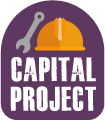Capital Project Updates
Just like a home, school facilities need regular attention and upkeep to continue to operate year after year as originally intended. The cost of keeping up with the daily wear and tear caused by hundreds of students, staff and visitors, year after year, can rise above and beyond what the annual school budget can support. Capital Improvement Projects are a strategic way for school districts to complete a larger amount of facilities work sooner than otherwise possible within the scope of the annual school budget.
At any given time, the Greater Johnstown School District has multiple projects happening simultaneously throughout the District. Each of them are in different phases. In an effort to keep the community informed on the progress of each project, we have created this Capital Project Updates page.
On the right side of this page, you will see links to all of the various projects that are taking place. As each project moves forward and enters a different phase, the District will update the page for that specific project, so that the community can stay informed and be part of the process. Please be sure to check this page for updates.
From start to finish, capital projects take years to complete. The process requires school officials to think years ahead, while considering current variables in the District. In general, each project follows the same process. Here are the steps:
Identify facilities challenges and opportunities
New York school districts are required to conduct regular building condition surveys and to develop multi-year facilities plans, which can help identify aging, outdated or energy inefficient school infrastructure and facilities issues related to health and wellness. Heightened safety concerns and changing job markets may also create a community demand for increased school security and improvements to classrooms and technology infrastructure.
Identify funding challenges and opportunities
With over 72 percent of the average school budget in Johnstown devoted to instructional expenses alone, school districts often look elsewhere to fund capital improvement projects. One source of funding is building aid provided by the state, which brings local tax dollars paid to the state back into the local community. Districts also use financing methods such as capital reserves and bonds, which are funded by local school property taxes, and are included in receipt of building aid on capital expenses.
Present Project to Board and Community: Set work priorities and seek community feedback
With information on facilities needs and funding sources, districts can determine how much work might be possible with what level of local tax impact. Districts often share this information during public meetings, in newsletters, on websites, via local media. These methods allow districts to gather community feedback and refine the scope of the capital improvement project.
Make a capital improvement project proposal
Districts work with their Board facilities committee and audit and finance committee to finalize details of a project and then make a recommendation to the Board of Education for approval. A school district Board of Education approves final recommendations for the cost and scope of the capital improvement project and sets a public vote date.
Voters decide on the proposal through the public vote
Voter approval is required for all capital improvement projects in New York state. For most school districts, a simple majority of voter support (50 percent plus one) is needed for passage. Small city school districts seeking to exceed their constitutional debt limit must secure a supermajority (60 percent).



